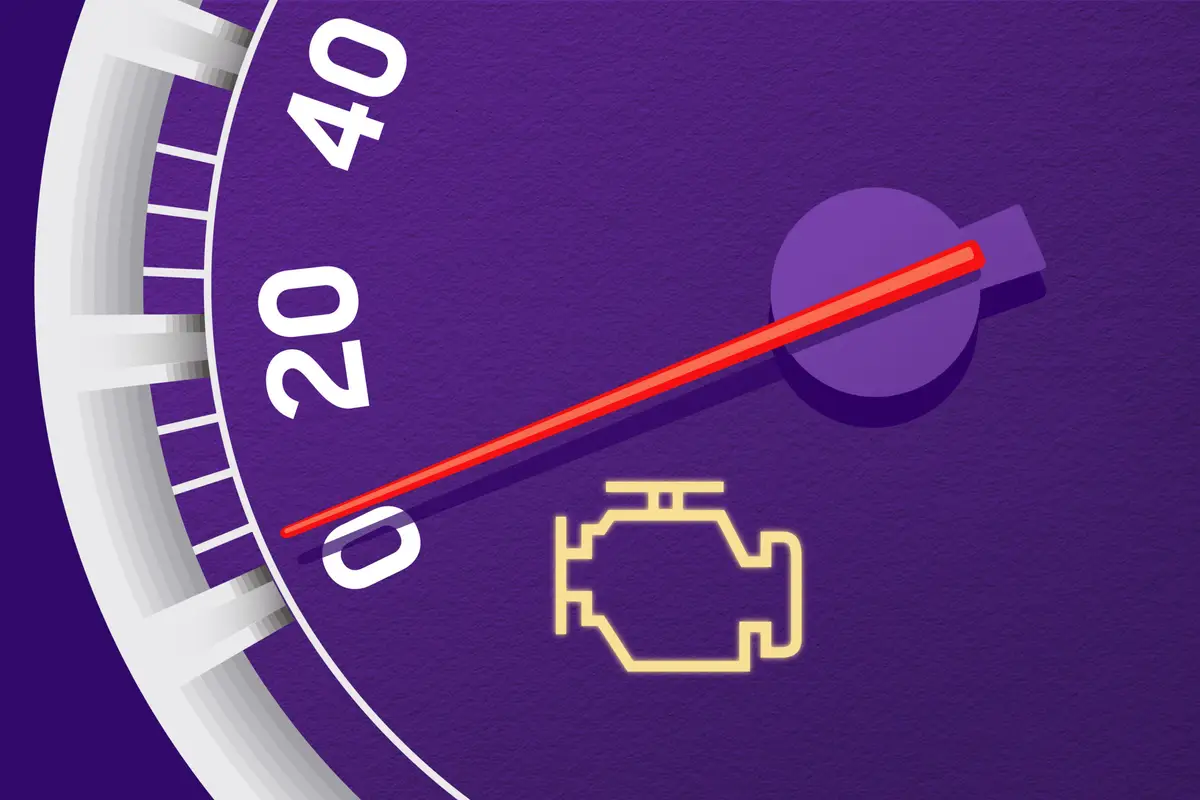What Does the Check-Engine Light Mean?

Although commonly referred to as the “check-engine light,” some cars may instead display the message “Service Engine Soon,” or show a yellow or orange outline of an engine, perhaps with the word “Check” on the instrument panel. (If you’re not sure what yours looks like, it should come on for a couple of seconds — along with all of the other warning lights — when you first turn on the ignition.) But no matter what the light looks like in your car, they all mean the same thing: Your car’s computer has detected a problem with something that should be addressed.
Related: Should I Worry About How Hot My Engine Is Running?
While that “something” is often related to the emissions system, it could also be a mechanical problem with the engine or even an issue with the transmission. In most cases, it isn’t a serious problem if the light is on steady, though it still needs to be checked out as soon as it’s convenient. A flashing light, however, indicates a much more serious problem that should be addressed immediately. If that’s the case, you should also check for other warning lights that might be on that would point to a particular problem (e.g., low oil pressure or the engine overheating) that might require pulling the car off the road and turning off the engine.
How Do I Know What’s Triggered the Check-Engine Light?
Since the 1996 model year, cars and light trucks have had what is known as an “OBD2” (sometimes written as “OBD II”) system, which stands for onboard diagnostics, second generation. This system brings two benefits: First, when the computer has detected a fault, it activates the check-engine light and stores a distinct trouble code for that fault. In some cases, the trouble code virtually pinpoints the problem; in others, it provides good guidance toward the cause.
Second, the trouble codes can be read by universal devices that work on almost all 1996-or-newer vehicles. These devices vary from inexpensive code readers that may only display the trouble code itself (and you can look up its meaning in a chart or online) to more sophisticated scan tools and diagnostic computers that can give readouts in real time, which is particularly helpful with intermittent problems.
While some auto-parts stores will check the trouble codes for free, simple code readers can be purchased at big box stores and online for about $30 and aren’t difficult to use. (Tip: If you have the codes checked by an auto-parts store or a friend with a code reader, watch to see how it’s done; it may help you get over that “first time” hurdle if you decide to buy a code reader for yourself.) However, more sophisticated scan tools and diagnostic computers can cost hundreds of dollars and are usually only practical for repair shops.
Note that some cars from the 1980s through the 1995 model year may have a check-engine light as part of a more primitive diagnostics system that’s now called OBD1. This type of system, however, isn’t as good at pinpointing problems and is far more difficult to decode, as there weren’t universal code readers available for it.
Should I Ignore a Check-Engine Light?
In many cases when the check-engine light illuminates, the car may seem to be running fine, making it tempting to ignore. However, it may indicate a problem that’s relatively inexpensive to fix now, but that could cause a much more expensive problem to develop later. For instance, a misfire could be fairly cheap to fix, but if left unrepaired, it could cause a rich fuel mixture that could damage the very expensive catalytic converter. Also, if you don’t correct what might be considered a minor problem, a more serious issue could develop that would turn on the check-engine light, but you might not know about it as the light is already illuminated.
Although most check-engine malfunctions will require a code reader to diagnose, something simple to try is to make sure your gas cap is tightened — particularly if the light came on just after you filled your tank. In many cars, you have to tighten the cap until it hits a hard stop or you hear three clicks. A loose gas cap (or one that has been accidentally left off when the engine is started) can cause a leak in the system that is supposed to prevent fuel evaporation from contaminating the atmosphere, and that will activate the check-engine light. However, note that if you tighten a loose cap, it will take several on-off driving cycles to turn off the light (but that might occur before you have a chance to get the trouble codes read anyway).
Nobody likes to see the check-engine light come on, but as long as it’s not flashing — and your vehicle is model-year 1996 or later — it’s far better than having something go wrong and just having to figure out the problem yourself.
More From Cars.com:
- How Long Do Spark Plugs Last?
- What Is Top Tier Gasoline, and Why Should I Use It?
- What Is Limp Mode?
- Do You Really Need to Change Your Oil Every 3,000 Miles?
- More Service Advice
Related Video:
Cars.com’s Editorial department is your source for automotive news and reviews. In line with Cars.com’s long-standing ethics policy, editors and reviewers don’t accept gifts or free trips from automakers. The Editorial department is independent of Cars.com’s advertising, sales and sponsored content departments.
Featured stories

15-Year Car Loans Aren’t a Thing, But Americans Are Getting More Comfortable With Long Loan Terms

2025 Kia Telluride Review: Rougher Roads Ahead



